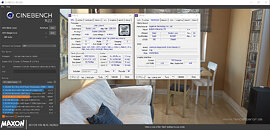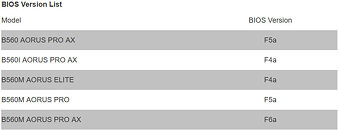Tuesday, March 30th 2021

The Latest BIOS of GIGABYTE B560 Motherboards Boosts i9 11900K CPU to All-cores 5.1 GHz
Gigabyte Technology, one of the top global manufacturers of motherboards, graphics cards, and hardware solutions, announces today the latest BIOS of B560 AORUS motherboards. Enhanced by the 12+1 phases DrMOS power stage with 60 Amps for each and full coverage VRM thermal design, B560 AORUS motherboards can support Intel Core i9 11900K (F) series processors overclocking to all cores 5.1 GHz. The exclusive anti-interference design of memory circuit enables DDR4 speed raising up to XMP 4800 MHz, and overclocking performance boost to DDR4 5300 MHz. which demonstrates GIGABYTE's strong R&D strength and persistence in quality. Users can enjoy the performance boost of time-limited overclocking by simply updating to the latest BIOS to meet their special needs.1
Intel B series chipset motherboards have been always excluded from overclocking due to the product positioning. Although the memory XMP overclocking is unlocked on 500 series, the processor frequency can only reach up to 4.8 GHz by Turbo Boost. Thanks to the efforts of Gigabyte's R&D team, the processor can be overclocked to 5.1 GHz and maintain low temperature under the Prime95 no AVX burn-in test. This powerful performance benefits from the top-quality materials of GIGABYTE AORUS motherboards and product design capabilities, which include 12+1 phases/ 60Apms DrMOS power stage, 6 layers 2Oz ultra-cool PCB, full-covered VRM thermal design, and the latest Smart Fan 6 technology for temperature control. These features allow processors to have a stable and pure power supply under ultra-high frequency operation, providing the most solid backing for the CPU limited-time overclocking.Besides the unlocking of time-limited overclocking performance on B560 motherboards, GIGABYTE AORUS B560 series motherboards adopt Daisy Chain layout with memory anti-interference mask by embedding the memory circuits within the PCB ground layers while the metal outer layer of the PCB reduces electromagnetic interference, so the more purified memory signal can boost the memory XMP to DDR4 4800 MHz. By manually overclocking, the memory frequency can be further reached to DDR4 5300 MHz while competitors can only achieve the same speed with Z590 high-end motherboards. GIGABYTE B560 AORUS motherboards take a commanding lead on the CPU and memory overclocking of the same level rival products, and even can compete to high-end models.
Optimized by exclusive hardware design, GIGABYTE B560 AORUS motherboards unleash the bandwidth of VGA cards and storage devices with integrated PCIe 4.0 interface. With the PCIe 4.0 controller, it can perfectly release the extreme accessing performance to 7000 MB/s of the latest SSDs. Meanwhile, the 2.5GbE and WiFi 6 networking provides users with faster and more flexible connections, as well as USB 3.2 Gen 2x2 high-speed transmission and the front USB Type-C interface offers a faster and more convenient external expansion.
The latest BIOS of GIGABYTE B560 AORUS motherboards have been uploaded to GIGABYTE's website, and users can download the corresponding BIOS to further experience the various functions from the best choice of high-end PC and gaming console. For more information, please refer to GIGABYTE's official website:
https://www.gigabyte.com/tw/Motherboard/Intel-B5601. The DDR4 5300 MHz, the operation time and range of CPU time-limited overclocking are laboratory data, The actual performance will vary depending on the processor configuration, motherboard hardware design, and related peripheral configurations and settings.
Intel B series chipset motherboards have been always excluded from overclocking due to the product positioning. Although the memory XMP overclocking is unlocked on 500 series, the processor frequency can only reach up to 4.8 GHz by Turbo Boost. Thanks to the efforts of Gigabyte's R&D team, the processor can be overclocked to 5.1 GHz and maintain low temperature under the Prime95 no AVX burn-in test. This powerful performance benefits from the top-quality materials of GIGABYTE AORUS motherboards and product design capabilities, which include 12+1 phases/ 60Apms DrMOS power stage, 6 layers 2Oz ultra-cool PCB, full-covered VRM thermal design, and the latest Smart Fan 6 technology for temperature control. These features allow processors to have a stable and pure power supply under ultra-high frequency operation, providing the most solid backing for the CPU limited-time overclocking.Besides the unlocking of time-limited overclocking performance on B560 motherboards, GIGABYTE AORUS B560 series motherboards adopt Daisy Chain layout with memory anti-interference mask by embedding the memory circuits within the PCB ground layers while the metal outer layer of the PCB reduces electromagnetic interference, so the more purified memory signal can boost the memory XMP to DDR4 4800 MHz. By manually overclocking, the memory frequency can be further reached to DDR4 5300 MHz while competitors can only achieve the same speed with Z590 high-end motherboards. GIGABYTE B560 AORUS motherboards take a commanding lead on the CPU and memory overclocking of the same level rival products, and even can compete to high-end models.
Optimized by exclusive hardware design, GIGABYTE B560 AORUS motherboards unleash the bandwidth of VGA cards and storage devices with integrated PCIe 4.0 interface. With the PCIe 4.0 controller, it can perfectly release the extreme accessing performance to 7000 MB/s of the latest SSDs. Meanwhile, the 2.5GbE and WiFi 6 networking provides users with faster and more flexible connections, as well as USB 3.2 Gen 2x2 high-speed transmission and the front USB Type-C interface offers a faster and more convenient external expansion.
The latest BIOS of GIGABYTE B560 AORUS motherboards have been uploaded to GIGABYTE's website, and users can download the corresponding BIOS to further experience the various functions from the best choice of high-end PC and gaming console. For more information, please refer to GIGABYTE's official website:
https://www.gigabyte.com/tw/Motherboard/Intel-B5601. The DDR4 5300 MHz, the operation time and range of CPU time-limited overclocking are laboratory data, The actual performance will vary depending on the processor configuration, motherboard hardware design, and related peripheral configurations and settings.


24 Comments on The Latest BIOS of GIGABYTE B560 Motherboards Boosts i9 11900K CPU to All-cores 5.1 GHz
So like turbo boost then. :shadedshu:
not bad really, considering the cooling needed to push past PL2.
But the real question is: why the hell would anybody in their right mind pair an 11900K with a b560 board? :wtf: :kookoo:
:)
I miss the times with P67 times. 2500k OC'ed to 4.5GHz. Good old days.
back then i only did air cooling, so it could have gone higher
But the i9 11900k exists solely to milk some $$$ out of consoomers who dont understand CPUs, or want that pretty intel i9 badge. So you may have a point, nobody with the thought process that leads to an i9 11900k purchase will be thinking sensibly enough to look at b560 boards.Yeah it only needs to boost to 5.1 GHz and consume the same amount of power as a local sun to do it :kookoo: :roll: :kookoo:My 3570k was stable at 4.7 GHz at only 1.075v; one of the last costa rican chips, used a coolermaster 212+ with dual fans. Those were the days, before everything was OCing out of the box.
:roll:
The difference here being that AMD actually improved. Zen 1 was a beta quality core, but the 2000 series was far better, and weve all seen what zen 2 and zen 3 have managed.
Intel's new architecture is a power hungry braphog, a true successor to netburst. the fact it cant keep up with zen 3 in many cases is damning enough, just wait until zen 4 shows up. Hope intels atom cores can do CPR to keep the big cores running long enough to finish a "real world benchmark".
Let me also reiterate, because too often is this fact of paramount importance either ignored or forgotten, that Intel has a net worth 258% greater than AMD's net worth and in the 2020 fiscal year, Intel spent 684% more on research and development than AMD, and in spite of intel's staggering advantage in resources, AMD is still managing not only to compete with Intel, but to beat them on all fronts. Based on the drastic differences in resources, not only is it incredibly impressive that AMD is able to outperform Intel, but even if AMD's CPUs were, for example, 10% behind in overall performance, it would still be impressive that AMD were able to achieve that with their comparatively shoestring budget. In other words, Intel has absolutely zero excuses for not crushing AMD and any attempts to be bragging about, for example, "Intel still able to compete with 14nm", should be framed against these drastic financial disparities between the two companies.
Discuss the topic, not two companies who don't give a damn about your existence.
--
Has Gigabyte solved the issue where the BIOS would go "ight, imma head out" whenever you changed a DRAM timing wrong?
www.techspot.com/review/1678-amd-ryzen-threadripper-2990wx-2950x/page7.htmlActually while AMD is chipping away at Intel's market share and profit, I feel the biggest threat for Intel is actually ARM. There are already a lot of big clients who have moved away from the Intel chips and diversified with their own custom chips. This is where Intel actually makes the most money and with them losing sales over time, it will hit Intel hard at some point. With ARM chips making waves in the form of Apple's M1, Intel is also under attack in the retail market now. Frankly Intel still have the deep pockets to compete effectively, but its no more a cake walk for them nowadays.
Intel should put restrictions on motherboard vendor to follow specs on all there chip sets, other wise most people would notice high power draw and Tepretures at """STOCK""" then blame intel.Also am pretty sure Gigabytes high end B boards are 50 Amps stages
Yup